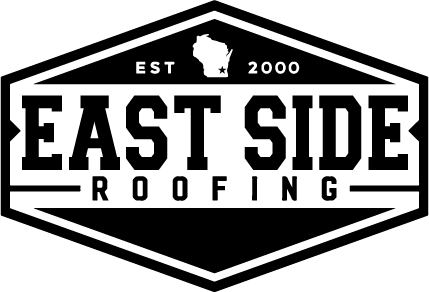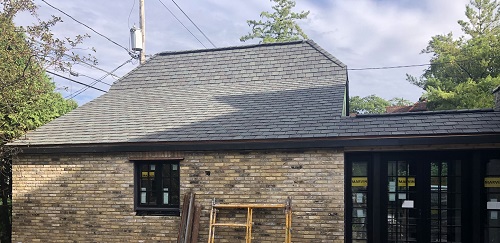TPO is an innovative material making waves in the roofing industry, and for good reason. Its combination of durability, energy efficiency, and cost-effectiveness is quickly making it a favorite among both homeowners and commercial businesses.
As seasoned roofers with a particular knack for TPO roofing, we’ve seen first-hand the impact this material can have on a building’s performance and aesthetics. In this article, we’ll explore the ins and outs of TPO roofing. From its benefits and drawbacks to how it compares with other traditional roofing materials like asphalt, slate, and tile. East Side Roofing is here to provide you with all the information you need to make an informed decision.
Understanding TPO Roofing
In the world of roofing, TPO (Thermoplastic Polyolefin) has emerged as a bit of a modern marvel. At its core, TPO is a single-ply roofing membrane with heat-reflective qualities and strong resistance to ultraviolet, ozone, and chemical exposure. This type of roofing material is made primarily from a blend of polypropylene and ethylene-propylene rubber, resulting in a highly durable yet flexible roofing solution. One of the key features of TPO is its ability to weld seams together, creating a bond that’s as strong as the membrane itself. This unique characteristic significantly boosts its waterproofing capabilities and longevity.
Initially developed as a more economical and efficient alternative to PVC (polyvinyl chloride) roofing, TPO has undergone significant advancements over the years. Its evolution has been marked by continual improvements in its formulation to enhance its durability, longevity, and environmental resistance. Today, TPO is widely recognized for its balance of performance, cost-effectiveness, and environmental sustainability, making it a highly sought-after roofing material for both residential and commercial applications.
Pros and Cons of TPO Roofing
TPO roofing, like any material, comes with its unique set of advantages and drawbacks. Understanding these can help you make an informed choice about whether it’s the right fit for your building. Let’s break down the pros and cons:
Pros:
- Durability:
- TPO roofing is renowned for its resilience against a variety of weather elements, standing up well against rain, wind, and even hail.
- It can withstand thermal expansion and contraction, which is a common issue in fluctuating temperatures.
- This durability ensures a longer lifespan, reducing the frequency of needing a roof replacement.
- Lightweight:
- The lightweight nature of TPO minimizes the stress on a building’s structure, making it an excellent choice for both new constructions and retrofitting older buildings.
- For residential homes, the light weight means easier handling and faster installation, with less impact on the overall structure.
- Easy to Install:
- TPO roofing membranes typically come in wide sheets, which means fewer seams and a quicker installation process.
- This ease of installation translates to reduced labor costs and less disruption to daily operations, particularly important for commercial establishments.
- The welding process of TPO ensures a secure and water-tight seal, providing added protection against leaks.
Cons:
- Susceptible to UV Ray Damage:
- While TPO is good at reflecting UV rays, prolonged exposure can lead to material degradation over time.
- This susceptibility means that in areas with high UV radiation, TPO roofs may require more frequent inspections and maintenance to ensure longevity.
- The impact of UV rays can lead to discoloration and material weakening, affecting both the aesthetic and functional aspects of the roof.
- Difficult to Repair:
- Repairing TPO roofing can be more challenging compared to other materials like asphalt or metal.
- This difficulty is often due to the need for specialized equipment and expertise to properly weld and seal the material during repairs.
- The unique composition of TPO means that finding matching materials for repairs can sometimes be a hurdle, potentially leading to visible patchwork.
- Limited Design Options:
- TPO primarily comes in standard colors like white, grey, and tan, offering limited aesthetic diversity.
- This limited range can be a drawback for homeowners or businesses looking to maintain a particular architectural style or color scheme.
- While the functional benefits of TPO are significant, the lack of design versatility can influence the decision-making process for those where aesthetics are a high priority.
Weighing these pros and cons is essential in determining if TPO roofing is the right choice for your specific needs. While it offers impressive durability and ease of installation, considerations like UV sensitivity, repair complexity, and aesthetic limitations play a crucial role in the decision-making process.
TPO vs. Asphalt Roofing
Asphalt roofing is one of the most common roofing materials out there, especially for residential homes. It’s made from a fiberglass mat, topped with asphalt and mineral granules. This composition gives it a notable degree of durability and versatility. Asphalt shingles are favored for their ease of installation, wide range of styles, and relatively low cost. They’re a go-to for many homeowners due to their traditional aesthetic and ability to fit into various architectural styles.
- Durability:
- TPO roofing generally offers greater durability than asphalt, especially in terms of resistance to tears, punctures, and weathering.
- Asphalt shingles can be prone to cracking and can lose granules over time, especially in areas with extreme weather conditions.
- Cost:
- Initially, asphalt roofing tends to be more cost-effective than TPO. However, the longer lifespan and energy efficiency of TPO can make it more economical in the long run.
- Installation & Maintenance:
- Asphalt shingles are relatively easy to install and repair, making them a popular choice for DIY enthusiasts.
- TPO installation, while more straightforward due to larger sheets and fewer seams, usually requires professional installation. In terms of maintenance, TPO might need more attention in areas with high UV exposure.
- Aesthetic Options:
- Asphalt shingles offer a wide variety of colors and styles, making them more adaptable to different home designs.
- TPO, on the other hand, is limited in color options and has a more utilitarian appearance, which might not appeal to those looking for a specific aesthetic.
Both TPO and asphalt roofing have their unique strengths and weaknesses. Your choice will largely depend on factors like durability, cost, aesthetic preferences, and the specific environmental conditions of your area.
Find the Best Roofing Material with East Side Roofing
TPO is a roofing material that stands out for its durability, lightweight nature, and energy efficiency, making it a fantastic option for those looking for a modern, cost-effective roofing solution. The decision on which roofing material to choose ultimately boils down to your specific requirements – be it durability, cost, aesthetic preference, or structural considerations. It’s crucial to weigh these factors carefully, as your roof is a significant investment that impacts not just the appearance of your building, but also its functionality and longevity.
East Side Roofing is among a select group of companies in the greater Milwaukee area specializing in a wide range of roofing materials, including TPO, slate, tile, and more. With our unmatched expertise and attention to detail, East Side Roofing ensures every project is executed with precision and craftsmanship.
Contact us today to learn more about TPO roofing for your Milwaukee home or commercial business.
Check us out on Facebook!


